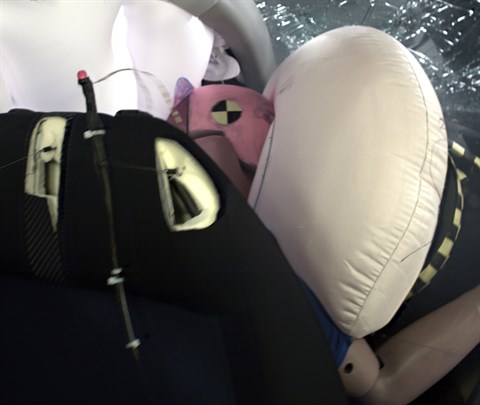Small overlap front: driver-side
Rating applies to 2016-21 models
Tested vehicle: 2016 Honda Civic LX 4-door
The Honda Civic was redesigned for the 2016 model year. The ratings also apply to the 4-door hatchback version of the Civic, introduced in the 2017 model year.
| Evaluation criteria | Rating |
|---|---|
| Structure and safety cage | |
| Driver injury measures | |
| Head/neck | |
| Chest | |
| Hip/thigh | |
| Lower leg/foot | |
| Driver restraints and dummy kinematics | |

Action shot taken during the small overlap frontal crash test.

The dummy's position in relation to the door frame, steering wheel, and instrument panel after the crash test indicates that the driver's survival space was maintained very well.

The frontal and side curtain airbags worked well together to control the dummy’s head movement, although the head hit the steering wheel on the left side as the frontal airbag was bottomed out.

Forces during the crash contributed to a moderate risk of injury to the dummy's right lower leg.
Moderate overlap front: original test
Rating applies to 2016-21 models
Tested vehicle: 2016 Honda Civic Touring 4-door
The Honda Civic was redesigned for the 2016 model year. Moderate overlap frontal ratings are assigned by the Institute based on a test conducted by Honda. The ratings also apply to the 4-door hatchback version of the Civic, introduced in the 2017 model year.
| Evaluation criteria | Rating |
|---|---|
| Overall evaluation | |
| Structure and safety cage | |
| Driver injury measures | |
| Head/neck | |
| Chest | |
| Leg/foot, left | |
| Leg/foot, right | |
| Driver restraints and dummy kinematics | |
Side: original test
Rating applies to 2016-21 models
Tested vehicle: 2016 Honda Civic LX 4-door
The Honda Civic was redesigned for the 2016 model year. Side ratings are assigned by the Institute based on a test conducted by Honda. The ratings also apply to the 4-door hatchback version of the Civic, introduced in the 2017 model year.
| Evaluation criteria | Rating |
|---|---|
| Overall evaluation | |
| Structure and safety cage | |
| Driver injury measures | |
| Head/neck | |
| Torso | |
| Pelvis/leg | |
| Driver head protection | |
| Rear passenger injury measures | |
| Head/neck | |
| Torso | |
| Pelvis/leg | |
| Rear passenger head protection | |
Roof strength
Rating applies to 2016-21 models
Tested vehicle: 2016 Honda Civic LX 4-door
Rating applies to both the Civic 4-door sedan (tested) and 4-door hatchback versions and to the structurally similar 2019 and later Insight 4-door sedan.
| Overall evaluation | |
|---|---|
| Curb weight | 2,738 lbs |
| Peak force | 15,829 lbs |
| Strength-to-weight ratio | 5.78 |
Head restraints & seats
Seat type: Manual cloth seat
| Overall evaluation | |
|---|---|
| Dynamic rating | |
| Seat/head restraint geometry |
About the head restraint & seat test
Currently, IIHS tests apply only to front seats.
Headlights
Ratings are given for 3 different headlight variations available on this vehicle.
Trim level(s)
- LX trim equipped with Honda Sensing package
- EX trim equipped with Honda Sensing package
- EX-L Navi trim equipped with Honda Sensing package
| Evaluation criteria | Rating |
|---|---|
| Low-beam headlight type | Halogen projector |
| High-beam headlight type | Halogen reflector |
| Curve-adaptive? | No |
| High-beam assist? | Yes |
|
Overall rating | |
| Distance at which headlights provide at least 5 lux illumination: | |
Low beams
On the straightaway, visibility was fair on the right side of the road and inadequate on the left side. On curves, visibility was inadequate in all 4 tests.
The low beams never exceeded glare limits.
High beams
On the straightaway, visibility was good on the right side of the road and fair on the left side. On curves, visibility was inadequate in all 4 tests.
High-beam assist compensates for some limitations of this vehicle's low beams on the straightaway and all 4 curves.
Trim level(s)
- LX trim
- Sport trim
- EX trim
- EX-L Navi trim
| Evaluation criteria | Rating |
|---|---|
| Low-beam headlight type | Halogen projector |
| High-beam headlight type | Halogen reflector |
| Curve-adaptive? | No |
| High-beam assist? | No |
|
Overall rating | |
| Distance at which headlights provide at least 5 lux illumination: | |
Low beams
On the straightaway, visibility was fair on the right side of the road and inadequate on the left side. On curves, visibility was inadequate in all 4 tests.
The low beams never exceeded glare limits.
High beams
On the straightaway, visibility was good on the right side of the road and fair on the left side. On curves, visibility was inadequate in all 4 tests.
Trim level(s)
- Sport Touring trim
| Evaluation criteria | Rating |
|---|---|
| Low-beam headlight type | LED reflector |
| High-beam headlight type | LED reflector |
| Curve-adaptive? | No |
| High-beam assist? | Yes |
|
Overall rating | |
| Distance at which headlights provide at least 5 lux illumination: | |
Low beams
On the straightaway, visibility was good on both sides of the road. On curves, visibility was fair on both right curves and inadequate on both left curves.
The low beams created excessive glare.
High beams
On the straightaway, visibility was good on the right side of the road and inadequate on the left side. On curves, visibility was fair on the gradual left and both right curves and inadequate on the sharp left curve.
High-beam assist compensates for some limitations of this vehicle's low beams on the straightaway, on both left curves and on both right curves.